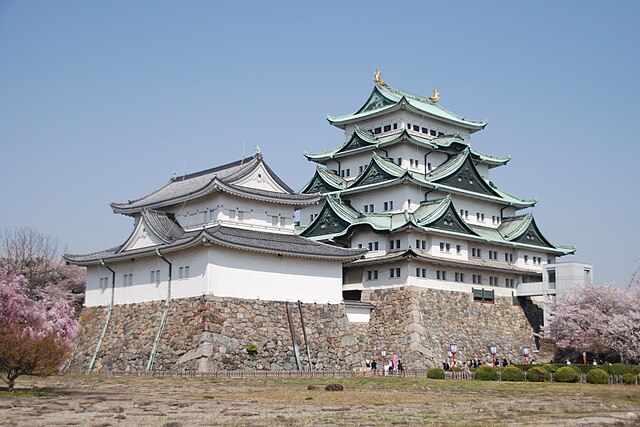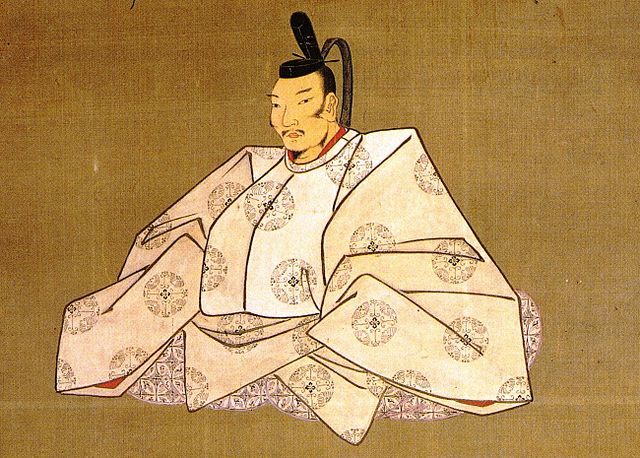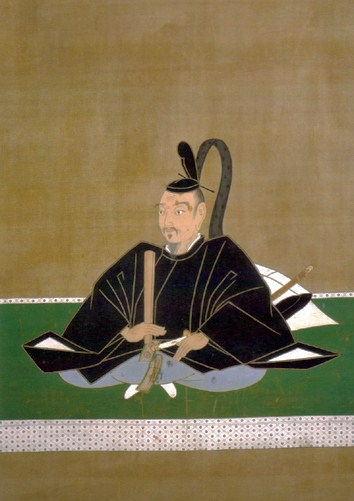Campaigning in the Kwanto
Hideyoshi now decided on subduing the last of the Lords who
had hitherto failed to submit to him; Hojo of the Kwanto. When Hojo was called
to the capital to declare himself a vassal, he refused despite apparently being
advised to attend by Ieyasu. Hideyoshi then accused Hojo of plotting rebellion,
promising to march against him the following year.
Hideyoshi had been preparing for this showdown for some
years, ordering the collection of hostages in Kyoto from all his tributary
lords. He ordered that the lords of the Kinia mobilise their men; Ieyasu had to
produce seven men per hundred koku[i].
 |
| Tokugawa Hidetada as an adult |
At the beginning of 1589 Ieyasu sent his heir Nagamaru to Hideyoshi
as a hostage and Hideyoshi’s wife organised Nagamaru’s coming of age ceremony
and as a compliment he was given the first character of Hideyoshi’s name,
henceforth he would be known as Hidetada. She also asked her husband to return
Hidetada to his father. In return Ieyasu sent a cousin as hostage.
Roughly contemporaneous with Nagamaru’s arrival as a
hostage, his step-mother died. Ieyasu was busy preparing the Tokaido Highway
for use during the forthcoming military adventures, castles needed renovation
and rest-houses prepared.
In 1590 150,000 men surrounded Hojo’s town of Odawara. It
took three months before the castle surrendered and Hojo Ujimasa and his
younger brother Ujiteru committed seppuku. Hideyoshi gave Ieyasu the Lordship
of the eight provinces of the Kwanto; in return Ieyasu gave back the four
provinces he had obtained for himself and his ancestral fief of Mikawa,
rendering himself more vulnerable to Hideyoshi.
Edo
Hideyoshi immediately gave Ieyasu’s former fiefs to his own
supporters, bottling Ieyasu into the Kwanto. On the advice of Hideyoshi, Ieyasu
decided to make Edo his capital and on 1st August 1590 made his
first entrance into the town, which was little more than a village. He had only
been given the Lordship of the Kwanto on 14th July and the rapidity
of his decision to relocate the capital stunned even Hideyoshi.
‘The
Lord Tokugawa’s way of doing things is really extraordinary.’[ii]
The grants of lands to his followers Ieyasu left to Ina
Kumazo Tadatsuga, making him Daikwan[iii] of the Kwanto. Tadatsuga
stayed in this role until his death in 1615. In that time he was heavily
involved in the reclamation of the Kwanto, putting down brigands, administering
justice and improving communications and increasing revenues.
Korea and the Death of
Hideyoshi
Nagoya Castle
In December 1592 Hideyoshi announced his intention to invade
Korea. The vanguard was to depart the following March to be followed by an army
of over 270,000. Hideyoshi arrived at the forward base, Nagoya, in April 1593.
He appointed Ieyasu as supreme commander of all Diamyos in the Eastern
Provinces. Hidetada was left in charge in Edo, while Ieyasu travelled to Nagoya
with 15,000 men. Ieyasu had also provided a number of war-vessels to transport
his men across to Korea.
Toyotomi Hidetsugu
The war was to continue intermittently for six years, until Hideyoshi’s
death, during which time Ieyasu remained in Japan. In 1591 Hideyoshi retired
from the role of Kambaku and took the title Taiko[iv]. His nephew and heir Hidetsugu
took the title Kampaku. Ieyasu was one of those appointed to the new Kambaku’s
council of advisers. Hideyoshi had intended to prosecute the war in person, but
had been dissuaded by his mother, to whom he was extremely attached and by the
Emperor. He now spent a lot of time entertaining and being entertained (at
great expense to his hosts) in Kyoto.
Sometime after the birth of his son Hideyori, in September
1593, Hideyoshi handed over Osaka Castle to him. At the same time he decided on
the rebuilding of Fushimi, for his son now designated his successor. The castle
was rebuilt within the year at the expense of the Daimyos.
At the end of 1595 Hidetsugu was forced to commit seppuku,
having been charged with treason by his uncle the Taiko[v]. Hideyoshi had his
nephew’s wife, consorts and children put to death on a common execution ground.
Ieyasu was not impressed with Hideyori’s actions.
‘I
don’t think you did well at all in this. If the Kambaku was at fault, could you
not have banished him somewhere or other? It is a pity you acted with such
harshness. You are getting on in years now, while Hideyori is only a baby. If
anything untoward should happen the Empire would have been safe if the Kambaku
had been alive.’[vi]
In May 1596 Ieyasu was promoted to the Upper Second rank at
Court.
In September 1596 the Chinese envoys attended on Hideyoshi
at Fushimi; they failed to announce his accession as Emperor of China as he had
expected. Negotiations between the two states were broken off and Hideyoshi
again declared war on Korea, claiming that they were the cause of his quarrel
with China. Early the following year Hideyoshi launched the armies of the
Daimyo’s on Korea, while he tarried in Japan entertaining and being
entertained.
In August 1598 Hideyoshi, already ill, died suddenly leaving
only an infant child to succeed him as de facto ruler of Japan.
The Road to Sekigahara
Hideyoshi had already set up a council of regents, including
Ieyasu, to rule Japan until Hideyori was old enough to act in person. After
Hideyoshi’s death the other regents were upset by Ieyasu’s politicking. He
arranged a number of political marriages for his children and grandchildren.
This had been forbidden by Hideyoshi, in an attempt to stop the formation of
political cliques.
The Regents had to act in concert with the five Bugyo[vii] who had worked for
Hideyoshi throughout his period in power. The two groups appointed three
interveners to ensure cooperation between them. One of the Bugyo, Ishida
Mitsunari immediately complained of Ieyasu’s infringement of the rules on
political marriages. The problem was submitted to the Regents for their
consideration.
Troops massed in Kyoto and Fushimi, but eventually the
Regents agreed with Ieyasu that it was a minor matter. Ieyasu pointed out that
the Bugyo had failed to act by the rules on all occasions and the matter was
smoothed over. It is possible that Ieyasu was testing the waters at this point.
Ieyasu was asked to resign by the other Regents, but he ignored them.
Hideyori was residing at Osaka Castle with his guardian
Maeda Toshiie, while Ieyasu was at Fushimi. In 1599 Ishida was attacked, by a
number of generals whom he had upset[viii] on a visit to Osaka to
pay his respects to the dying Maeda. He escaped dressed as a lady and fled to
take refuge with Ieyasu in Fushimi, despite authorship of a recent attempt to
kill his host[ix].
Ieyasu sent Ishida home with his son Hidetada as an escort. Even while staying
with Ieyasu, Ishida was calling on his allies to attack his host.
It is believed that his senior adviser Honda Masanobu
advised Ieyasu to let Ishida foment the nascent opposition. With Ishida at its
head it would be easier for Ieyasu to act against them, as Hideyori was still
just a child of seven, and Ishida could be portrayed as acting in his own
interests. Ieyasu now suggested that the Daimyos, who had borne the burden of
the Korean war, retire to their fiefs. Many left for their respective provinces
to prepare for war.
Adams meets Ieyasu
After Maeda’s death Ieyasu stayed the first few months of
1600 with Hideyori at Osaka Castle. During this stay Will Adams[x], the English Pilot-Major
of a Dutch trading fleet blown ashore in Japan[xi], was brought before
Ieyasu. Ieyasu was more than happy to receive the cargo of the Liefde, which he
confiscated and detained its crew. Ieyasu had the Liefde sailed to Uraga[xii].
Ieyasu received notification that Uesegi Kagekatsu, one of
Ishida’s allies, was building a new castle at Kazashigahara; allegedly using
70,000 men on the construction working day and night. In May Ieyasu invited
Uesegi to visit Osaka to explain the work he was having done and in default of
the proposed visit sent en envoy, who narrowly escaped assassination. Uesegi’s
neighbour informed Ieyasu that the peace of the region could not be guaranteed
unless Uesegi was curbed.
Ieyasu left Osaka on 18th June, making a
leisurely journey down to Edo, spending much of the trip hawking, as well as
visiting the Lords of Kuroda, Hosakawa and Date. Ieyasu reached Edo on 2nd
July and after a few days moved on to Koyoma in Hitachi, where Hidetada was
overseeing the operation against Uesegi Kagekatsu. He held a council of his
allies and received the news that Ishida had declared war. Ieyasu offered the
families of the hostages in Osaka, held by Ishida, the chance to side with the
western allies[xiii],
no-one took him up on the offer.
Ieyasu called on his allies to attack Uesegi. The Satake
transferred their allegiance to the western alliance, while the Maeda were
unable to attack as they were pinned down by attacks from hostile neighbours.
The combined forces of Date and Mogami kept Uesegi sufficiently occupied that
he was unable to give Ishida any assistance.
To ensure freedom of movement for his armies Ieyasu sent
detachments of men to take key positions on the Tokkaido and the Nakasendo[xiv]. The most important of
these was the castle of Kiyosu in Owari, held by Osaki Gemba, known as Devil
Gemba. The castle was a key point between the two roads and control of the
castle meant control of the region. Ishida too recognised the castle’s
strategic value and attempted to persuade Gemba to hand the castle to him.
Gemba called for help from the eastern allies and the castle was held for
Ieyasu.
Torii Mototada
By September 30th the western allies had captured
a number of key strategic points and settled at Akasaka to await Ieyasu. An old friend of Ieyasu, Torii
Mototada undertook to Ieyasu to hold his strategic castle of Fushimi to the
end. Ishida and his allies besieged the castle. The castle was taken after one
of the defenders, under threat of having his family crucified, betrayed
Mototada. Three hundred and fifty men died with Mototada after a siege lasting
two weeks. What was left of the fortress was hardly worth the cost of gaining
it.
On 7th October Ieyasu left Edo at the head of an
army of 30,000 men and on the 12th had reached Shimada in Suruga.
Two days later he had a message of support from Kobayakawa Hideaki[xv].By the 19th
Ieyasu was at Gifu and the following day the western army was on the march to
Sekigahara.
Bibliography
Sekigahara – Anthony Bryant, Osprey Publishing Ltd 1995
Samurai William – Giles Milton, Hodder & Stoughton 2002
The Maker of Modern Japan – AL Sadler, Charles E Tuttle
Company 1983
Tokugawa Ieyasu Shogun – Conrad Totman, Heian 1983
En.wikipedia.org
[ii]
The Maker of Modern Japan - Sadler
[iii]
District Commissioner
[iv]
Retired Kambaku
[v]
Possibly because he stood between Hideyori and the succession
[vi] The Maker of Modern Japan
- Sadler
[vii]
Administrators
[viii]
Ishida was a brilliant financial administrator but a very rigid personality,
who got on badly with the military.
[ix]
Ieyasu was probably aware of this attempt.
[x]
A veteran of the fleet put together to fight the Armada, captaining one of the
ships.
[xi]
Of the remainder of the fleet one ship made its way back to Holland, one ship
sank, one was taken by the Spanish and the other by the Portuguese.
[xii]
Kanagawa Prefecture
[xiii]
Ishida’s party.
[xiv]
The key roads to the capital
[xv]
The nephew of Hideyoshi’s wife





Hideyoshi rated Ieyasu highly as the Kwanto was the rice basket of Japan; holding its provinces was almost a licence to print money. No wonder Ieyasu jumped at the exchange! It's also notable how much Hideyoshi rated Ieyasu that he was able to make the outspoken criticism of the Taiko's handling of the execution of the kwampaku's family. As it happened Ieyasu was the greatest threat to the infant Hideyori, but then, the Age of the Country At War being as it was, it is possible to imagine far worse carnage had not a strong leader like Ieyasu taken the helm.
ReplyDelete